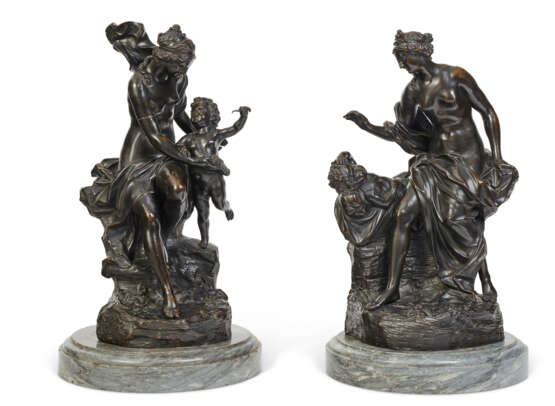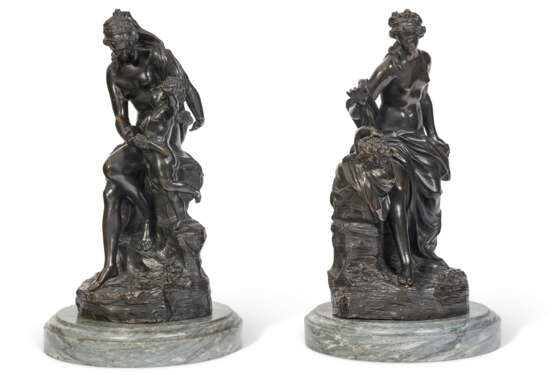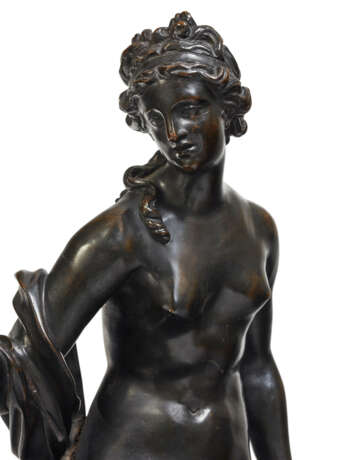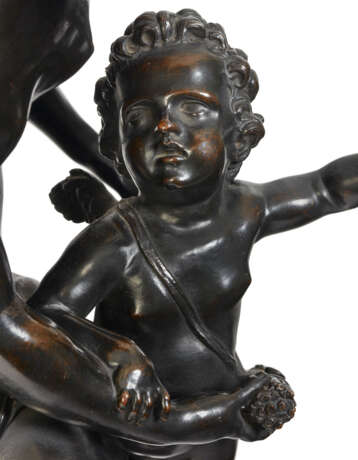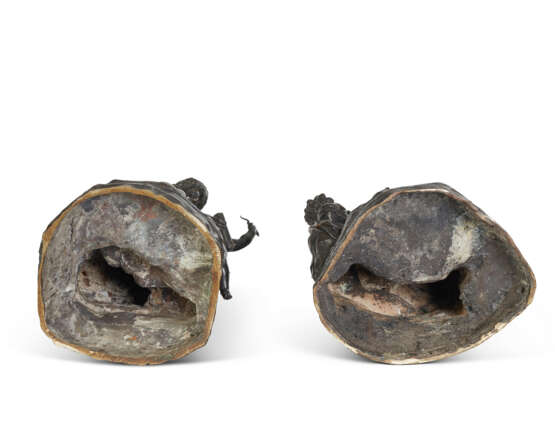ATTRIBUÉS À L`ATELIER OU SUIVEUR DE CORNEILLE VAN CLÈVE (1646-1732), DÉBUT DU XVIIIe SIÈCLE
11.12.2025 00:00UTC +00:00
Classic
Pour enchérir, allez sur le site
CHRISTIE'S| Auctioneer | CHRISTIE'S |
|---|---|
| Lieu de l'événement | Royaume-Uni, London |
| Commission | see on Website% |
ID 1514308
Lot 100 | ATTRIBUÉS À L'ATELIER OU SUIVEUR DE CORNEILLE VAN CLÈVE (1646-1732), DÉBUT DU XVIIIe SIÈCLE
Valeur estimée
30000EUR € 30 000 – 50 000
Vénus désarmant Cupidon et Psyché découvrant Cupidon
paire de groupes en bronze, chacun sur une base circulaire postérieure en marbre bleu turquin
H. 48 et 47 cm. (19 et 18 ½ in.) ; bases : H. 5,5 cm. (2 1/8 in.), D. 31 cm. (12 ¼ in.)(2)
Provenance
Probablement Edgard-Salomon Stern (1854-1937) et Marguerite Stern née Fould (1866-1956), 20 Avenue Montaigne, Paris (selon les archives RA 8, MAEE, Paris) ;
D'où probablement confisqués par le Einsatzstab Reichsleiter Rosenberg suite à l'occupation allemande de la France (ERR inv. non référencé, décrits comme « Femme et amour – Deux groupes bronze Louis XIV patine brune ») ;
Restitués à Marguerite Stern le 4 octobre 1946 ;
Puis par descendance.
Literature
Bibliographie comparative :
The French Bronze, 1500 to 1800, cat. exp. New York, 1968, cat. 43A, B.
F. Souchal, French Sculpture of the 17th and 18th centuries - The reign of Louis XIV, Oxford, 1981, vol. III, pp. 394-395 et vol. IV, p. 196.
G. Bresc-Bautier, G. Scherf et J. D. Draper (dir.), Bronzes français de la Renaissance au Siècle des Lumières / Cast in Bronze. French Sculpture from Renaissance to Revolution, cat. exp. musée du Louvre, Metropolitan Museum of Art, J. Paul Getty Museum, Paris, 2009, pp. 412-415, cat. 113 et 114.
Further details
A PAIR OF BRONZE GROUPS REPRESENTING VENUS DISARMING CUPID AND PSYCHE DISCOVERING CUPID, ATTRIBUTED TO THE WORKSHOP OR FOLLOWER OF CORNEILLE VAN CLEVE (1646-1732), EARLY 18TH CENTURY
The two groups depict the myth of Psyche and Cupid.
Told by the Roman writer Apuleius in the 2nd century AD, the myth gained great popularity in the 17th and 18th centuries, largely thanks to Jean de La Fontaine, who published a version in 1669. The first group shows Cupid and his mother Venus. The second captures the moment when Psyche, who had been forbidden to discover her lover’s identity, approaches him as he sleeps. In her excitement, she spills oil from her lamp, waking him and provoking his anger.
These groups have often been presented as a pair since sales in the 18th century. For example, one can cite those from the Le Marié collection in 1776 (The French Bronze, cat. 43A, B, note 1). These two groups also appear in the 19th and 20th centuries, such as in the collection of Baroness S. de Gunzburg (Galerie Georges Petit, Paris, 17 May 1912, lot 100), as well as in museum collections, including the Staatliche Kunstsammlungen in Dresden (inv. H4 153/3 and H4 153/7), the Herzog Anton Ulrich Museum in Brunswick, and the National Museum of Western Art in Tokyo. A version of Psyche Discovering Cupid is held at the Wallace Collection in London (inv. S186), as well as at the Hermitage Museum in Saint Petersburg (Winter Palace, inv. H.CK-477).
These models were long attributed to Corneille Van Clève (1645–1732), a sculptor from a family of Flemish goldsmiths. Trained in the workshop of Michel Anguier, he spent several years in Rome and Venice before returning to France in 1678, where he was admitted to the Académie de Peinture et de Sculpture in 1681. Van Clève cast his own sculptures, intended for a wealthy clientele. Neither of the subjects of the Stern bronzes is mentioned in his posthumous inventory, nor are these themes referenced as works by Van Clève in 18th-century sale descriptions. The attribution to Van Clève was first suggested in 1968, when a cast of the model was exhibited at the Heim Gallery in London, and an attribution was proposed by comparing the Dresden example with a now-lost marble group depicting Venus Disarming Cupid, begun by Jacques Sarazin and completed by Van Clève. However, today, some art historians dispute this attribution, assigning the design and execution of the bronzes to a follower from his circle. This was the opinion of Robert Wenley and, more recently, of Guilhem Scherf in the exhibition Cast in Bronze. French Sculpture from Renaissance to Revolution. Both Wenley and Scherf believe that although the groups closely resemble Van Clève’s style and mostly date to the years 1715–1720, their execution and finish rule out the possibility that they were created by the master himself.
| Artiste: | Corneille Van Clève (1645 - 1732) |
|---|---|
| Technique appliquée: | Construction métallique |
| Matériel: | Bronce |
| Genre: | Peinture mythologique |
| Lieu d'origine: | Europe de l'Ouest, France, Europe |
| Catégorie maison de vente aux enchères: | Tous les autres types d'objets, Sculptures, statues et personnages, Statuettes |
| Artiste: | Corneille Van Clève (1645 - 1732) |
|---|---|
| Technique appliquée: | Construction métallique |
| Matériel: | Bronce |
| Genre: | Peinture mythologique |
| Lieu d'origine: | Europe de l'Ouest, France, Europe |
| Catégorie maison de vente aux enchères: | Tous les autres types d'objets, Sculptures, statues et personnages, Statuettes |
| Adresse de l'enchère |
CHRISTIE'S 8 King Street, St. James's SW1Y 6QT London Royaume-Uni | |
|---|---|---|
| Aperçu |
| |
| Téléphone | +44 (0)20 7839 9060 | |
| Commission | see on Website | |
| Conditions d'utilisation | Conditions d'utilisation |
